Links
The subject of the Gutians is far from the spotlight of the European “mainstream” studies, and far from the European “mainstream” interests. Too bad, since the Gutians may have made a major indirect and direct contribution to the composition of the Europeans and to the European history. A simple compound arithmetic would demonstrate an impressive result: allowing for a conservative 50,000 tribal alliance in 2000 BC, and an average demographic increase of measly 0.2%/year, in 4000 years the alliance would grow to 150,000,000, about a half of the European population. Even if only one of ten Gutian descendents would migrate to Europe with the uncounted nomadic migration waves, their number would be quite compatible with the entire populations of the, say, Scandinavian countries. Adding to that that we all have 4 grandparents, 8 great-grandparents, and so on, by the time we reach 160 generations, with 4 generations/century, the whole population of the globe including the Gutians, would have to be enlisted many times over as our ancestors. A drop of the nomadic Gutian blood must be flowing in the veins of many of us. No country in Europe, and most countries in the Eurasia have not lived through the migrations of the nomadic pastoralists. The Gutians, like the rest of the Mesopotamia and other civilizations, belong to all of us.
Monopolies on, and secrecy regarding information, no longer exist in the 21st century. The distribution and rapid diffusion on the Internet of the archeological explorations, genetic studies, and scientific publications made the former privileged and closely guarded information available to all. Judgment and biases of the original investigators are very quickly exposed and criticized by those interested in the subject matter. It is a tough time for tribal, racial, and religious patriots trying to fake or prolong their own reality.
The modern understanding of the country is “A territory occupied by a politically organized body of people under a single government”. This definition has long roots, ascending to Sumer and Egypt, it evolved within sedentary milieu of politically coherent population, it covers countries from large to small, from Russia (No 1 large) to Vatican City (No 249 small). The core of this definition is “territory”, people and governments are transitional. Remove the territory, and the country disappears, even if the body of people is organized under a single government, like the diasporas ruled by a single clerical government. This definition co-exists with another, non-synonymous understanding that must have preceded the territorial definition.
The second definition has people at its core, it is “People united under a common government”. Under this definition fall bodies where people are permanent, but territories and governments are transitional. With increased proportion of sedentary agriculturists and demarcation of territories, a feature of the Late Middle Ages, the countries under the second definitions gradually dissolved. Among numerous countries defined by people and not territories are the Türkic nomadic states, which had changed their territories and governments many times over, while retaining their cohesion. Because they do not fall under the territorial definition, these countries are routinely named after their dominant rulers or tribes, they were even called ephemeral, and frequently are discounted altogether. Ironically, the epithet ephemeral was applied to the most consequential countries of the Eurasia, like the Hunnic Empires, Türkic Kaganates, and Mongol Empire. And since people, unlike the territories, are living creatures, they are subject to the influences destined to the living: they move, spread, mutate, adopt and adapt, amalgamate, blend, change their appearance, language, etiology, wither, and rebound. They learn, teach, transmit knowledge, invent and forget. They appear and melt away. They have their own laws of development, distinct from the laws that govern development of the territorial entities. In a chopped-down patriotic version of the history, their existence and behavior differ from the territorial entities, but in a continuous history they are no more ephemeral than the territorial states, which ultimately are composed of people and not territories.
Indications are that the name Gutians designated a tribal union rather than a specific tribe, it is equivalent of a “nomadic country”, just like the Saka, Scythians, Huns, Massagets, Suvars, Bulgars, Uigurs, etc. The observation that “their epithet was ‘wide-spread’,” corroborates the supra-ethnical nature of the term. The stand-off relation of the Gutians versus their neighbors Subartu points to at least two independent tribal unions in the 3rd mill. BC Mesopotamia comprising two independent nomadic states.
No written sources exist for the pre-historical period of South Siberia and Northern China. Archeology and paleoanthropology shed an uneven light on the societies and peoples there; the name of the Zhou nomads appeared in the early Chinese records in connection with the Shang period of Yin state. In contrast, Mesopotamia was endowed with a pioneering writing system and extensive body of historical and mundane records long preceding the migration of the Indo-Arian farmers to the Iranian Plateau. The Gutian history is known in broad terms from the Mesopotamian records. Gutians belonged to a cluster of horse nomadic tribes occupying eastern Taurus and Zagros mountains from about 3000 BC under peculiar tribal names rendered as Turuks (Turukkos), Lulu (Lullubians), Kassites, and Suvars (Subartu); the names that can be rendered Kangars (Akkad. Kienkir, after Sumerian endonym Kangarli or Kangar) and nomadic Komans, Kumugs, Kashgays, Gügers, Salurs, and unspecified others, also figure in the Mesopotamian cuneiform records. Dating of records and geography for the nomadic tribes are spotty; as a group, in archeology they are directly or obliquely compared with Scythians, either literal or metaphorical. Of the numerous nomadic designations, Gutians are seen as a powerful nomadic group that took over the rule of Sumer and Akkad for about a century. For the agricultural population and cities, the Gutian period (ca. 2154 – 2112 BC in short chronology, 124 years on the outside) was a disaster, cities and irrigation were ruined, fields were used for pastures. The names Scythians and Gutians are rather proverbial, they serve as an allegoric model to describe a distinct phenomena in familiar terms. The substance behind these retrospective metaphorical designations are real nomadic tribal confederations participating in historical events as seen by the settled inhabitants.
Map schematically depicts migrations in the Western Eurasia
In the Eastern Eurasia, Kurgan expansion reached Pacific
The Celtic Kurgan circum-mediterranean migration is not shown
Migration of non-Kurgan Indo-Aryan farmers ca. 2000-1500 BC
Arrows show flow, not the waves, i.e. they are timeless.
after https://en.wikipedia.org/wiki/File:IE_expansion.png
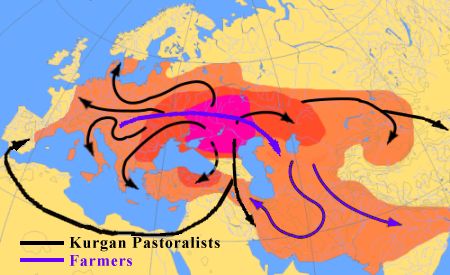
The historiography of the Gutians is brief. Gutians came to light after discovery, decipherment, and publication of the cuneiform inscriptions, and since the body of the inscriptions was humongous, it was a late and lengthy process. It involved Sumerologists, Assyriologists, and the like very inquisitive, patient and relentless minds. Once the scholars realized that other than the relatively late Semitic vernaculars they are dealing with agglutinative languages, they suggested association with the agglutinative Uralo-Altaic linguistic family, a classification that survived, albeit with major convulsions, till the 1950s. After that the Uralo-Altaic unity hopelessly fractured, breaking down into Altaist and anti-Altaist schism with continued further segmentation. At all stages, Türkic languages were at a focal point of the linguistic classificatory exercises. The first scholar who specifically studied Gutians was Benno Landsberger (1937), followed by Kemal Balkan (2000). Few other scholars suggested their own assessments. B. Landsberger, a chair of Sumerology at the Ankara University, was first to propose in 1937 that the Gutian language was not just some obscure agglutinative language, but was a language related to the Türkic linguistic family.1 The Fennic part of the “Uralo-Altaic” linguistic family was never invoked or asserted.
Gutians (and Lulubians) were recalled as ancestors of the Kurds and the local population of the Iranian Plateau and environs by the Georgia-born linguist and historian Nikolaĭ Yakovlevich Marr (1864-1934), and Ephraim Avigdor Speiser (1902-1965), Galicia-born Orientalist, and long-time Chairman of the Department of Oriental Studies (1947-1965) at the University of Pennsylvania, USA. They became proponents of a pre- and non-Indo-European (pre-Iranian) origin of the Kurds, whom they considered as indigenous, autochthonous (Zagros) people (Speiser, Mesopotamian Origins, 1930, 110-119). That proposal makes Kurds related to the Zhou Scythians and the other Türkic inhabitants of Mesopotamia, Turuks, Komans, Kangars, and Subars, recorded in the pre-Iranian cuneiform inscriptions.
Highlighted in yellow are the mountainous areas with foothills suitable for transhumant herd pasturing
Foothills in Türkic are called saqa, hence the appellation Saka for mountaineer pastoralists
(Cf. Tauar, Tagar for “mountaineer”, Suar, Suvar for “river people”, Alan, As, Yas for “steppe nomads”, Agachir for “forest people”, etc.)
after Balkan K., 2000
Click map to enlarge
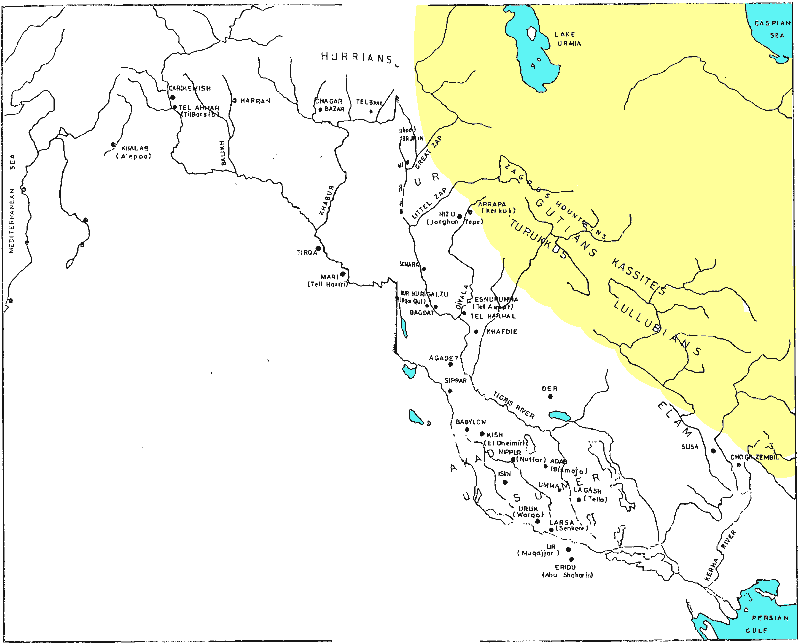
click to reduce
B. Landsberger illustrated his thesis with specific examples of the Gutian lexicon and morphological elements. The Gutians came to the fore again in the late 20th century. P. Dolukhanov, 1994, with a reference to the Assyrologist I. M. Diakonoff, posited that Gutians were distant relatives of the today's Dagestanies, called Kumyks in today’s lingo; Dagestanies lit. means “Mountaineers” in Türkic, a supra-ethnical appellation, and Kumyks was a late Middle Age appellation for the predominant Türkic population; J.Derakhshani, 1998, asserted that the Gutians were a Turanian tribe Tukri.2 The modern Kumyks are descendants from the agglomerate of the Türkic tribes of Masguts (Alans), Kayis (Kaitags), Huns (aka Savirs/Suvars), Khazars (Barsils), and Oguzes. The B. Landsberger’s thesis was analyzed by K. Balkan, 2000, with a detailed inventory and examination of the available Gutian material.3 K. Balkan turned to the Old Turkic to interpret Gutian titles and morphological elements, building on and adding more examples and morphological elements to the brief B. Landsberger’s list (El Ulumuş, Yarlagan, Tirigan, Şarlak, etc.), and advancing B. Landsberger’s resemblances to direct correspondences, like the name Ia-ar-la-ga-an-de of the founder of the Gutian dynasty with the ending –de, which turned to be identical with the Old Turkic locative noun suffix -da/-de (-da/-dä), “of judges”, “of tribunal”, and the like.4 The K. Balkan’s work was in accord with the F. Agasyoglu, 2000, work in the linguistic context, and E. Memiş, 2000, in the context of the Türkic history.5 M. Zakiev., 2002, addressed Guties in the context of the Türkic genesis.6 A “wide consensus” in such a limited field far from the interests of the Indo-Europeanist and Iranist scholarly mass may be counted with few fingers on one hand. An alternate suggestion that equates nomadic Gutians with the local sedentary farmers Kurds is untenable, because as Hurrites, the Kurds predate the arrival of the Indo-Arian farmers to the Iranian Plateau by millenniums.
The ample examples of the later common Türkic names for the tribes, like Guzzes, Oguzes, Goths, Masguts (Massaget), etc., each consisting of numerous tribes with their own designations, suggest that the word Gut, Kut, or Qut (Guti, Kuti, or Quti respectively in adjectival form, the form Gutians is an European form) is a generic designation derived from the meaning “clan, tribe”, and by extension “clansmen, tribesmen”, with the generic Guties meaning generic “(kindred) tribes”. That supposition parallels other examples of the generic names Gur (Bulgar, Uigur, etc., with regular r/s alteration) “(kindred) tribes” and Hun, the last meaning a straightforward “kin, kindred”. That proposal is corroborated and illustrated by the name Elulu (Elulumeŝ) of one of the early Gutian “kings”, who reigned simultaneously with an Old Akkadian sovereign. The name Elulu, with an archaic Türkic instrumental suffix -meŝ, is a transparent title-name compound of El “country, possession, tribal land”, down to “ancestral pasturing rout” + Lulu “tribal name”. Elulumeŝ's alternate title-designation was Yargan “Judge”. His names identify his position both in the tribal and in the federal hierarchies. Prior to the works of B. Landsberger and K. Balkan, these designations were treated as personal names functionally analogous to the personal names of the Semitic rulers, and the double naming of some Gutian rulers was a nagging puzzle.
| Sumer in the 3rd-2nd millenia BC |
N. Mesopotamian Türkic areal in the 20th-23rd cc. BC |
N. Mesopotamia Subar area in the 9th-8th cc. BC |
|---|---|---|
|
Illustrations after Firidun Agasyoglu, 2000 |
||
Click map to enlarge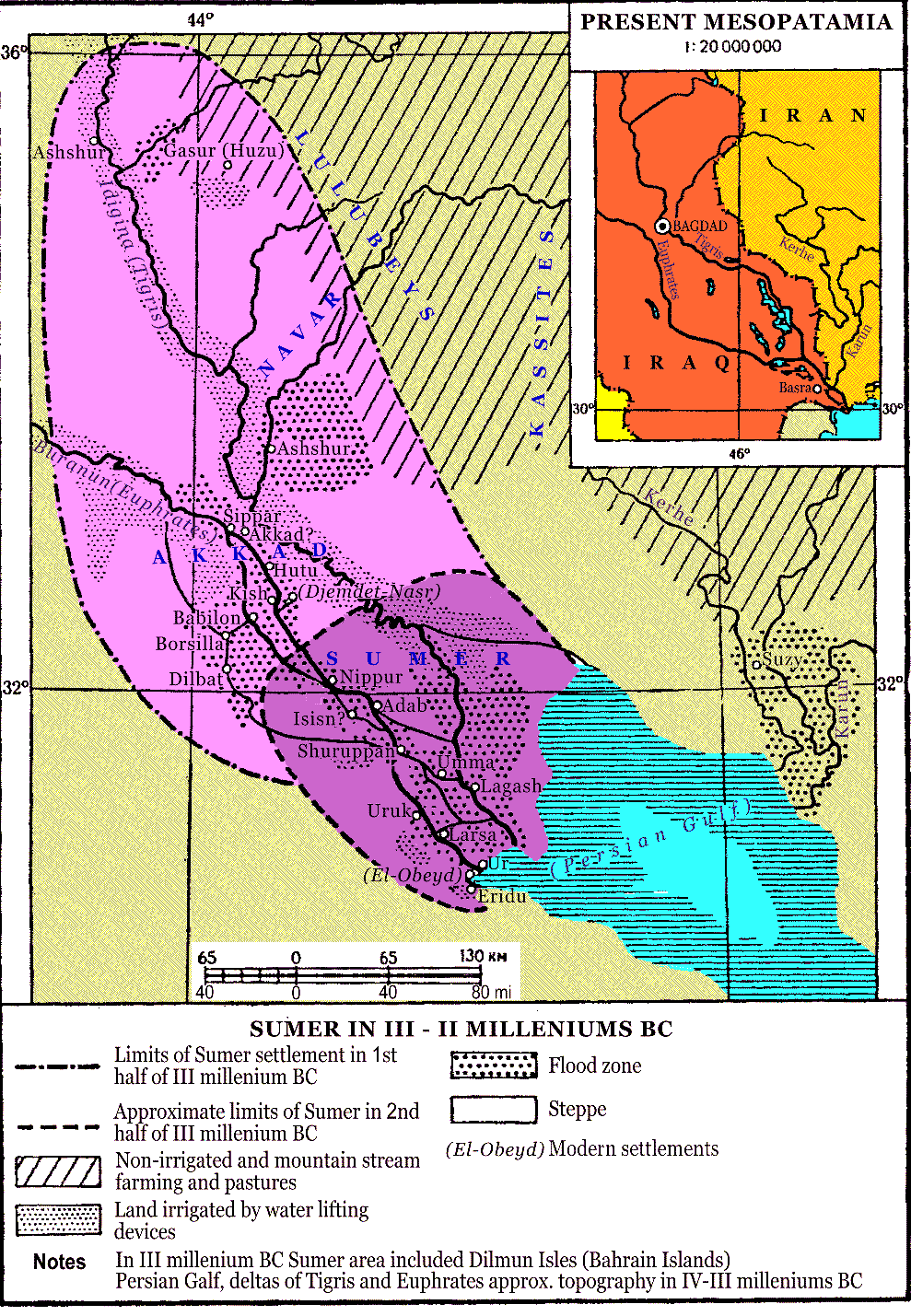 click to reduce |
Click map to enlarge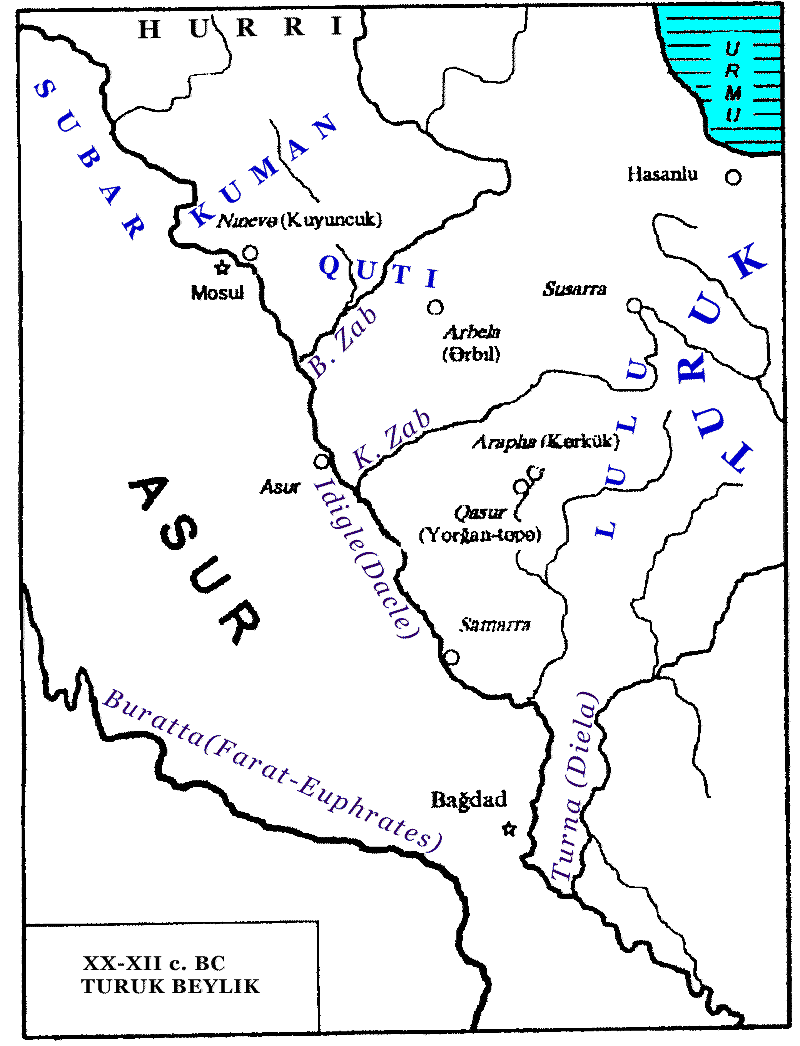 click to reduce |
Click map to enlarge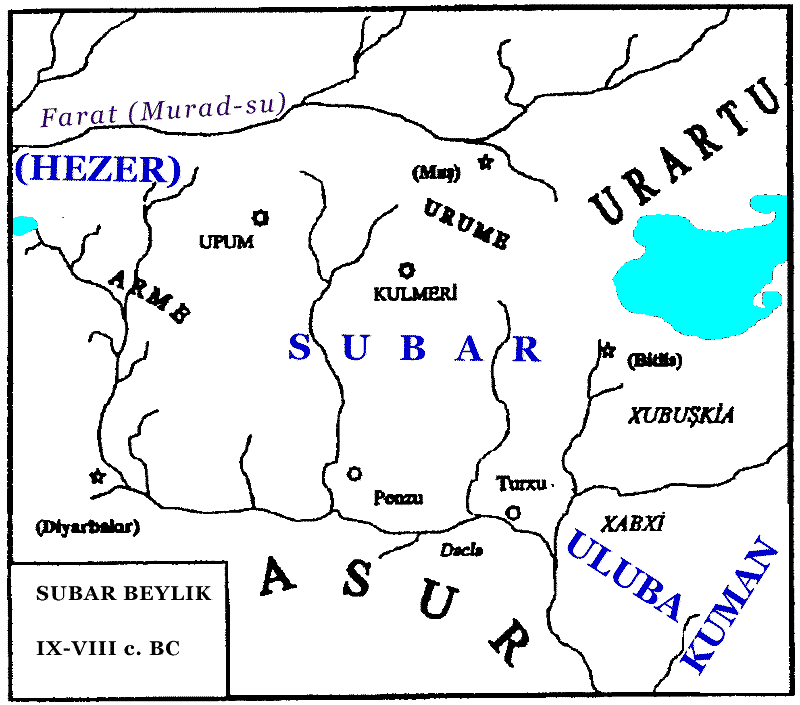 click to reduce |
The body of the Gutian-related records is not large, it provides mostly onomasticon and morphological elements. None of the neighborhood contemporary languages of the 24th-20th cc. BC come linguistically close to the Gutian, so the parallels must be sought elsewhere. It is generally agreed that onomastics is irrelevant in ethnological attributions (Cf. not all Alexanders are Greek, not all Joshuas are Hebrew); that is the oldest of the main objections to the V. Abaev & Co's Scytho-Iranian Theory (Cf. Dremin G. , 2006).7 A listing of the Gutian rulers is posted in Wikipedia, page https://en.wikipedia.org/wiki/Gutian_dynasty_of_Sumer; also see the synchronic listing of the Mesopotamian rulers ca. 24 - 22 cc. BC cited in K. Balkan, 2000, p. 124. That timeline is about all we know of the Gutian chronology.
The title-names do not fall into the category of the names because generally they are semantic designations peculiar to individual languages (Cf. title “King”, “Judge” in the European languages: Pol. krol; Lat. rex, regis; Hu. kiraly; Gmn. König; etc. vs. sędziavs; iudex; bíró; Richter, etc. respectively). The ethnical examination of the Gutian names as personal names, on the model of the European names, would be credible only with a questionable assumption that in the majority they are not borrowings but specifically Gutian native names. In case of the old Türkic names, the paradigm of names is further complicated by the absence of permanent names, the “child name” oğlan at is different from the early “adult name” er at, and that maybe changed to later “adult name” or a title-name. In contrast, the ethnical examination of the Gutian names as titles (title-names) is credible, since the assumption is that in majority they are not borrowings but peculiar Gutian native titles, and can be empirically validated by systemic concordance with the titles and morphology of a candidate language.
A most frequently used title of the Gutian rulers is read Yargan, which in Türkic corresponds to the title “Judge”,8 a member of a “tribunal”, and may be translated as “Tribune” (spelled yarğa:n in Clauson EDT, 1971, p. 963).9 That position and title were perpetuated in the Bible's Book of Judges, in the Roman Republic, and in the legend of the Round Table of the King Arthur with its Earl tribunes. The republican system does not fit well into the paradigm of the kings and monarchies expounded by the 20th cent. scholars on the Middle East, the Gutian title raised substantial scientific puzzlement and stray guesses. When the title Yarğa:n came to the attention of the Akkadian scribes it already was not new, then it lasted during the Gutian rule of the Akkkad and Sumer, and it outlived the Akkkadian Empire by more than 3000 years. G. Clauson cites the name-titles Inançu Apa Yarğan Tarxan (8th c. AD) and Boyla Kutluğ Yarğan Suci (9th c. AD) in Türkü and Uigur records,10 and Greek records have a regent Organa for Bu-Yurgan (7th c. AD).11 In these cases, the element Yarğan corresponds to the post of “judge, tribune” rather than “commander”, that is attested by the component Yarğan Suci meaning “Judge - Army Commander”, and the title Earl (a form of Yarğan) at the Round Table. The etymology of the position Yarğan ascends to the word yarğu: “splitter, tribunal, lawsuit, legal decision” denoting a legal tribunal at the head of the tribal administration, “i.e. an instrument for splitting facts and discovering the truth” from the verb yar- “to split, cleave”.12 Two more words relate to the post and add functional description: yarlığ is a “command (from superior to inferior), edict”, it has civil and military applications, and yarğu:n is a “destroyer, ruiner”, a derivative of the verb yar- “destroy, ruin” with clear war-time application. These terms are consistent with the verbs cited by K. Balkan, yarlïqa-, yarlïɣga- “to order, to command”.13 The phonetic and semantic consistency demonstrates a peculiar linguistic longevity across a period of four millennia, and the immense geographical spread from China to British Isles.
Since the term judge alludes to justice, the interpretation of the term is an equivalent to the expression “XYZ the Just”. The title Yarğan is loaded, it describes the republican system of the Guties' tribal organization, their tribal Council, and the position of the presiding Judge at the council; it asserts that in the 3rd mill. BC, Guties had the organization and military power to take over and rule the troubled Akkadian Empire. That is a model replicated in numerous cases, from the Türkic and Mongol empires to the Round Table of the King Arthur and the institution of the modern parliament. At least some words and concepts introduced by the ruling Guties had to be internalized (Cf. Gutium, the Semitic form) and eternized within the inheritor languages, including Babylonian and later Persian.
Another peculiar title of the Gutian ruler is Tirigan, which in Türkic corresponds to the title “Helper”, “one who aids”, a derivative of the verb tire- “buttress, pillar, support”. That title, with phonetic variations, is also attested in the later Türkic titulature, and in trades like nautical and architectural, like “boat-pole, punt-pole”. The title alludes to a Gutian officer that in today's nomenclature would be called “vice-”, “deputy”, “pro-term”, “substitute”, “relief”, “reserve”, and the like.
The archaic Türkic origin of the nomadic Guties and their constituent nomadic tribes is consistent and corroborates archeological, ethnological, historical, biological, and ethnical details associated with the nomadic mummy from the Tarim Basin. The Tarim Basin mummy from the Yanghai graveyard opened another porthole to the events of the 2nd mill. BC that shaped histories of the Eurasian peoples from one end of the continent to another. It is unavoidable that the Yanghai discovery will generate a wealth of scientific material illuminating many aspects of the ancient life. In broad terms, the historical outline has solidified, and likely, the new discovery will fall into the established scheme of things, adding, for example, another tested specimen to the database in excess of 120 thousand artifacts (as of 2008) in the study headed by E.N. Chernykh. Unlike the wool of the pants, which could come from the same breed of the sheep a continent apart, the chemical composition of the peculiar axe can pinpoint the exact source of the ore, tracing geography of its ultimate source to a specific point.
The Eurasian Metallurgical Province that was born in the Northern Balkans and extended eastward to the “steppe belt” at the very beginning of the Early Metal or the Copper Age in the 5th mill. BC. In the Steppes, all notable details of the material or spiritual life sharply contrast with those of the western neighbors. Typically, villages are marked by a thin cultural layer pointing to a mobile lifestyle. The farming there was absolutely unknown, and cattle was the main source of livelihood and concerns. Extending further eastward along the Eurasian Steppe Belt, in two waves metallurgy reached the vast areal of the Sayano-Altai mountain system in the Northern Kazakhstan, where it grew into the distinct East Asian Metallurgical Province that has developed its own advanced technologies and styles, with tubular sockets of the arrowheads and spear blades as one of its peculiarities. The crude metallurgical centers of the preceding period suddenly burst with high-tech production of thin-walled bronze castings of fine and unique forms of weapons, with cast spearheads, kelt axes, and curved knives with incipient images of Scythian triad's animals and even humans. Compared with the Eurasian Metallurgical Province, the East Asian Metallurgical Province had a much more complex structure.
Illustration after Fig. 8 in Chernykh E.N., 2008.
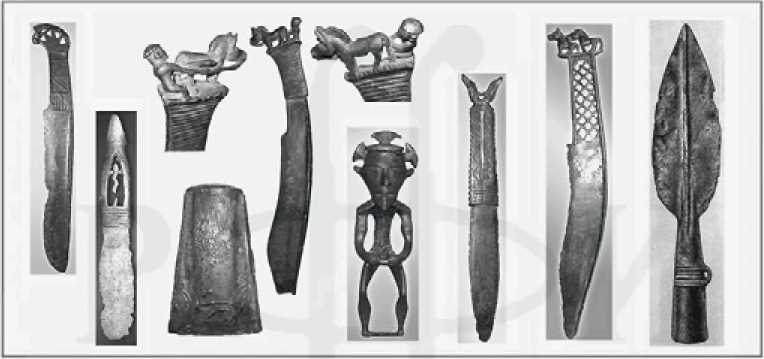
A vast majority of these peculiar products were found in cenotaph kurgan graves without human remains, spread from the Central China (that is, Zhou “Scythians”) to the Eastern Baltic for more than six thousand km from the center in the Sayano-Altai area. One salient product are the unique tubular socket axes found in Mesopotamia, in the Altai, and in the Northern China. In the Mesopotamia, they are attributed to the nomadic horse cattlemen Guties (Guzes, maybe Juzes from Juz “union, tribal confederation”), Turuks (Türk), Komans (Kumans), Kangars, Subars, and Lulu, in China they are associated with the nomadic horse cattlemen Zhou (Jous, Juz “union, tribal confederation”) and Juns (Rongs, probably standing for Huns), in the Altai they are associated with the Seima-Turbino metal production. The unique axes allow to connect the Sayano-Altai Kurganian nomads with the Guties in Mesopotamia at the end of the 3rd mill. BC and with the Zhou in China at the mid-2nd mill. BC. In China, the Zhous were more successful than the Guties in Mesopotamia, they ruled China for 1400 years, till the rise of the first Chinese Han Empire at the end of the 3rd c. BC. And due to the Chinese annals, we know of the Zhou much more than we know of the Guties.
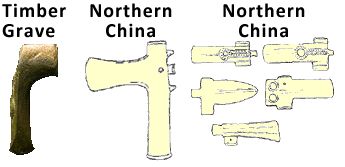
There is a huge lacuna in our knowledge of the Guties between the beginning of the second millennium BC and the beginning of the first millennium BC. As the Gutian rulers of the Sumer and Akkad, the Guties disappeared, the focus moved to the Babylonian Empire, and Guties fell into obscurity. A later map of the Northern Mesopotamia Subar area in the 9th-8th cc. BC shows Subars (Suvars), Ulubaies, and Kumans, and no Gutians. Gutians, whether a tribe or a tribal union, have vanished from the horizon of their neighbors. A few centuries later, the name Gut re-appears in the same general area as an ethnonym Massagetae with a Greek accent, lit. “Head Tribe”, and then as the ethnonym Masgut with an Armenian accent in the first centuries of our era. In the Greek nomenclature of the day, Massagetae - Masguts still were “Scythians”, and as Masguts they were allied with the “Scythian” Huns. At about the same time, in the second c. AD, on the European arena appear another Gut nomadic confederation, that of the Goths, who trekked from the Baltic to the Black Sea and took over the reigns from the Alans, lit. “Flat-Landers”. Since the name Gut is tentatively a generic for the “(kindred) tribes”, the continued use of this term does not imply a direct genetic connection, just like the terms Kingdom or Empire do not attest to any genetic connections between diverse kingdoms or empires. All it does is to attest to the vitality of the terminology. A juxtaposition of the Gutians and Goths compares populations temporally separated by about 22 centuries, or about 88 generations, and only paleogenetic studies could analyze and demonstrate that the number of mutations between the two populations is within reason for the known times to the common ancestor, if any. Still, the name of the Gutians is eternized in the compound Catalonia, where the part Cat is an allophone of the name Gut, attesting to the longevity of the terminology. The same logics applies to other murky traces, the Guzz (Oguz) migrants of the 10th c. AD may be connected with the Guties only terminologically, and may or may not have a common ancestor. Still, the name of the Gutians is eternized in the ethnonym Oguz, in the ethnonym Gagauz, and any other Türkic ethnonym with a component Gut or its allophone.
Besides the Lulu (Lullubians) tribe, another insight into the Gutian tribes was added by K. Balkan, 1954, work on the Gutian tribe of Kassites.14
Another insight into the Gutian tribes is on the tribe Turuks (Turukkos). Their name appeared in the records on the military expedition ca. 3000 BC of the Akkadian King Naram-Sin from Mesopotamia to Anatolia, where Akkadian traders were commercially active. He encountered an alliance of 17 Anatolian city-states united against Naram-Sin, one of which was called Turki and headed by a King İlşu-Nail.15 A millennium later, a tribe with the name Turukku featured in the Mari archives written in Babylon ca. 2000 BC. Turukkos lived in the area of the modern Mosul and Kirkuk, the Mari archives documents related to the Turukkos were published by G. Dossin, 1950, 1951,16 and further addressed in later publications.17, 18,19 The scholars note the similarity of the peculiar tribal ethnonyms Turki, Turuk, and the historical ethnonym Turk, the similarity of their animal husbandry economies, and the similarity of their tribal social organization, and express possibility that the ca. 3000 BC name Turki and the ca. 2000 BC name Turuk are the earliest attestations of the ethnonym Turk.
A certain community of Neolithic migrants traversed Eurasia from Kazakhstan to the Eastern Europe, bringing with them a peculiar animal husbandry producing economy, a peculiar etiology attested by kurgan burials, and a peculiar egalitarian social system; there, in the Northern Balkans, it learned of metallurgy, and in reciprocal migrations spread that practice back to their homelands. Along the way, the cattlemen learned to live symbiotically, for mutual benefit, with populations scattered along their spread. Unlike the sedentary societies, the social system based on voluntary principle was the only viable social system in the mobile and fluid pastoral world. The seeds of metallurgy blossomed into new techniques and beneficial products, and the reciprocal migrations of the mobile cattlemen spread it far and wide, seeding new amalgamated nations and new civilizations. A high mobility of the pastoralists gave them an upper hand in dealing with the sedentary foot hunter and agricultural societies on the fringes of the Steppe Belt, which kept enriching both the mobile and the sedentary peoples for the next 3 millennia, well into the Middle Ages. And now, in the 3rd millennium AD, the traces of the technological and social evolution, spearheaded by the peculiar mobile pastoralists, are still pulsating in the spread of egalitarianism, parliamentarism, and technical innovations connected with use of metals in the modern world.
References
1. Landsberger B., 1937, Basic questions of the early history of the Near East (Grundfragen der
Frühgeschichte Vorderasiens), Türkischer Geschichtskongress, Devlet Basımevi, Istanbul
2.
Dolukhanov Pavel, 1994, Environment and Ethnicity in the Middle East, Aldershot, Avebury,
cited in Suave Aydin, Trans., 1998, Old Middle East, Environment and Ethnic Structure (Eski
Ortadoğu’da Çevre ve Etnik Yapı), Ankara;
Derakhshani Jahanshah, 1998; Aryans in Near Eastern
sources of the 3rd and 2nd millennium BC (Arier in den nahöstlichen Quellen des 3 und 2
Jahrtausend) Chr. Teheran, 1-4
3. Balkan K., 2000, Relations between the Language of the Gutians and Old Turkish//Journal
of Erdemir, c. VI
4. Nadelyaev V.M. at al, eds., 1969, (OTD), Old Turkic Dictionary, p. 651 (In Russian)
5. Agasyoglu Firidun Djalilov, 2000, Azeri people (selected works)/(Azer halgy (sechmə
jazylar)), Baku, pp. 41-66, 156-162; Memiş Ekrem, 2000; Turkish antiquity (Eskiçağ’da Türkler), Konya, p. 57f
6. Zakiev Mirfatyh, 2002, Origin of Türks and Tatars, Insan, Moscow, ISBN 5-85840-317-4
7. Dremin George, 2006, Scythian-Sarmatian" vernaculars and "Scythian" dictionary of V.I. Abaev, online version
8. Clauson G., 1972, (EDT), Etymological Dictionary of pre-13th c. Turkish, Oxford, p.
963
9. Clauson G., 1972, EDT, ibid, p. 963
10. Clauson G., 1972, EDT, ibid, p. 963
11. Runciman S., 1930, A history of the First Bulgarian Empire, G. Bell & Sons Ltd., London,
p. 14, citing Nicephorus and John of Nikiou
12. Clauson G., 1972, EDT, ibid, p. 963
13. Balkan, 2000, ibid
14. Balkan K., 1954, Kassites (Kassitenstudien), American Oriental Society, vol. 1,
http://books.google.com/books/about/Kassitenstudien.html?id=4cvzSAAACAAJ
15 Güterbock H.G., Zeitschrift für Assyriologie, 1934, pp. 42-44
16 Dossin George, 1950, 1951, Archive Royal de Mari, vol. I-16, 69, vol. IV-21, 22, 23,
24, 25, 41, 45, 52, 70, 78, 79
17 Bayram Sadi, Kaynaklara Göre Güney-Doğu Anadolu’da Proto Türk İzleri//Türk Dünyası
Araştırmaları, No 62, p. 80,
http://turkmenhost.com/documents/Gerey/5000.htm
18 Histoire du Monde,
http://histoiredumonde.net/article.php3?id_article=1112
19 Memiş E., 2000, Turks in Antiquity (Eskiçağ’da Türkler), Konya,
pp. 57, 72, 74, 108